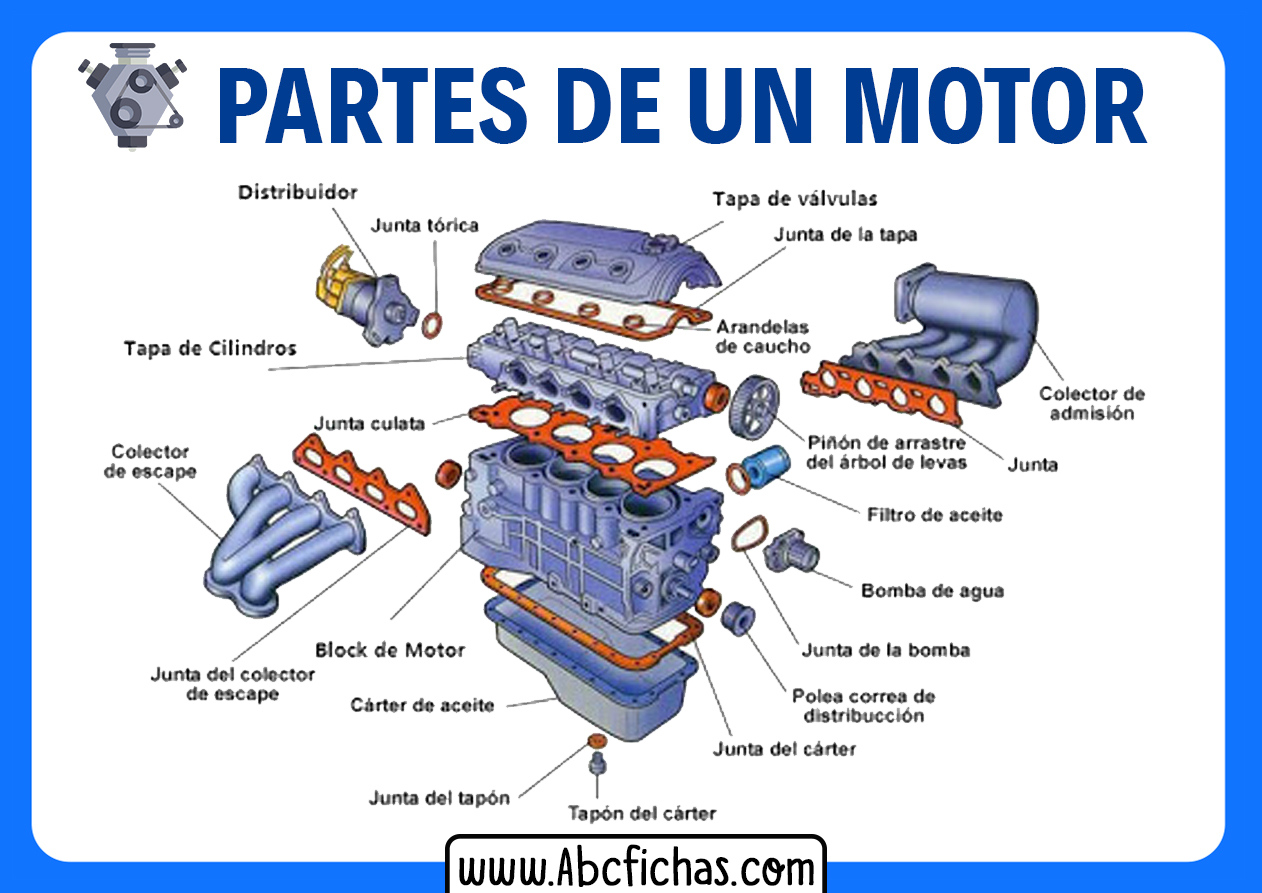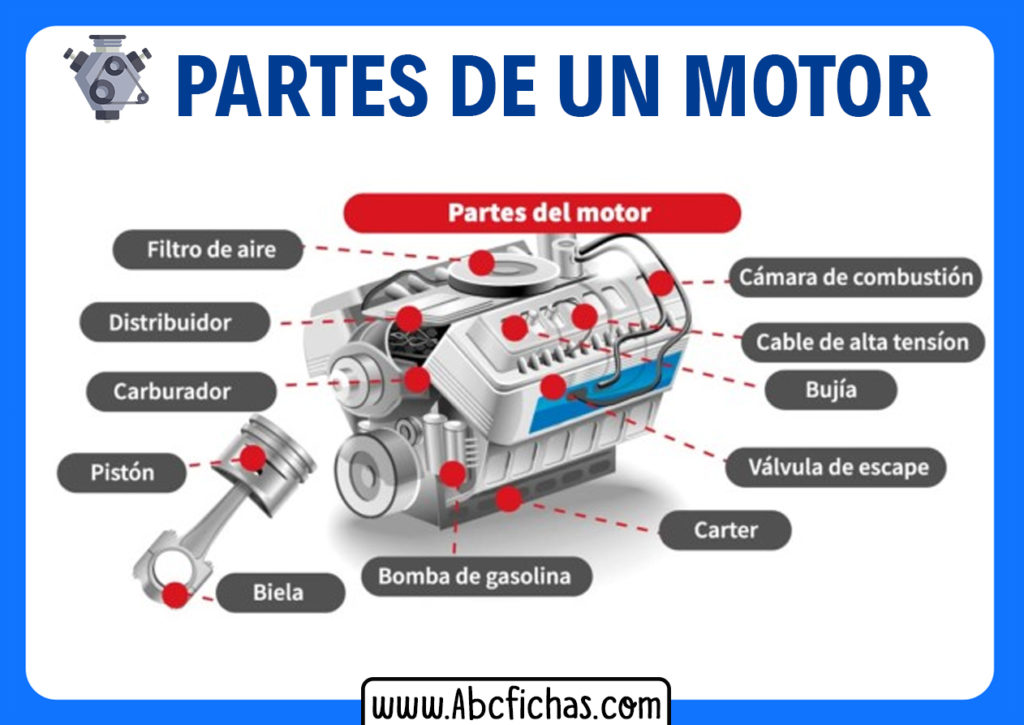You’ve likely seen them in a garage, on a boat, or even in a plane, but have you ever really thought about the intricate workings of an engine? These powerful machines are responsible for propelling everything from our cars to spacecraft, and understanding their components can be a fascinating journey into the heart of mechanics.

Image: www.abcfichas.com
In this comprehensive guide, we’ll dive into the world of engine parts, exploring their functions, types, and how they work together to create the force that drives our modern world. Whether you’re a curious beginner or a seasoned mechanic, this article will equip you with a deeper understanding of these essential components.
The Engine’s Foundation: The Block and Crankcase
1. Engine Block: The Solid Backbone
The engine block serves as the foundation of the entire engine, providing a rigid structure for all the essential components to be housed. It is typically cast from iron, aluminum, or a combination of both, possessing the strength to withstand immense pressures and vibrations. The block’s internal chambers, called cylinders, are where the combustion process takes place, transforming fuel into energy.
2. Crankcase: Keeping the System Sealed
The crankcase encloses the crankshaft and connects to the engine block. It plays a crucial role in maintaining the pressure within the engine, acting as a sealed chamber that houses the oil that lubricates moving parts. The crankcase also incorporates the oil sump, where excess oil collects and is later pumped back up to the engine.

Image: www.abcfichas.com
Power and Motion: The Crankshaft and Connecting Rods
3. Crankshaft: Translating Reciprocating Motion
The crankshaft is the central component that converts the linear motion of the pistons into rotational motion. This vital process is what ultimately turns the wheels of your car. The crankshaft consists of a series of throws, each connected to a connecting rod. As the piston moves up and down within the cylinder, the crankshaft rotates, transmitting the power generated by combustion.
4. Connecting Rods: Connecting Pistons to the Crankshaft
Connecting rods link the pistons to the crankshaft, creating a rigid yet flexible connection that allows the reciprocating motion of the piston to drive the crankshaft. These rods are typically made from forged steel and are designed to withstand the intense forces generated within the combustion process.
The Heart of the Engine: The Pistons and Combustion Chamber
5. Pistons: The Power Drivers
Pistons are the moving components that translate the energy released from the combustion of fuel into mechanical motion. They are cylindrical metal parts that move up and down within the cylinders. The piston’s crown forms the top of the cylinder, providing a sealed chamber for combustion to occur. The piston’s skirt ensures a tight fit within the cylinder, minimizing friction and maximizing efficiency.
6. Combustion Chamber: The Place Where Energy is Unleashed
The combustion chamber is the space within the cylinder where the fuel-air mixture ignites, releasing energy. The shape and volume of the combustion chamber are carefully designed to optimize the burning process, influencing the engine’s performance and efficiency.
Valves and Timing: Controlling the Flow of Air and Fuel
7. Valves: Regulating the Flow of Air and Exhaust Gases
Valves are essential for controlling the flow of air and exhaust gases in and out of the combustion chamber. These parts are typically made from lightweight materials that can withstand high temperatures and pressures. There are two main types of valves: intake valves, which allow air to enter the cylinder, and exhaust valves, which expel burnt gases from the cylinder. The precise timing of valve opening and closing is crucial for efficient combustion and engine performance.
8. Camshaft: Controlling Valve Timing
The camshaft is responsible for controlling the opening and closing of the valves, ensuring they operate in the correct sequence for optimal combustion. The camshaft has lobes that push on valve lifters, which in turn actuate the valves. The design of the camshaft determines the timing of the valves, influencing the engine’s power, efficiency, and sound.
Fuel and Ignition: Providing Energy and Starting the Process
9. Fuel System: Delivering Fuel to the Engine
The fuel system ensures that the right amount of fuel is delivered to the combustion chamber at the right time. This involves a complex series of components, including a fuel tank, fuel pump, fuel injectors, and fuel lines. The fuel system is responsible for regulating the flow of fuel, filtering it, and injecting it into the intake manifold or directly into the combustion chamber.
10. Ignition System: Igniting the Fuel-Air Mixture
The ignition system is responsible for igniting the fuel-air mixture within the combustion chamber, initiating the combustion process. Modern engines typically utilize spark plugs, which generate a high-voltage spark that ignites the mixture. However, other ignition systems, such as diesel engines, use compression to ignite the fuel.
Cooling and Lubrication: Keeping the Engine Running Smoothly
11. Cooling System: Regulating Engine Temperature
The cooling system works tirelessly to regulate the engine’s temperature, preventing overheating that can lead to damage. The system uses a coolant, typically a mixture of water and antifreeze, to absorb heat from the engine and transfer it to the radiator, where it is dissipated into the atmosphere. The cooling system consists of a radiator, water pump, thermostat, and hoses.
12. Lubrication System: Reducing Friction
The lubrication system is vital for reducing friction between moving parts within the engine, minimizing wear and tear. Oil is pumped throughout the engine, creating a film that separates moving surfaces, reducing friction and heat. The lubrication system comprises an oil pump, oil filter, oil pan, and oil passages.
Other Essential Components: Enhancing Performance and Functionality
13. Intake Manifold: Delivering Air to the Cylinders
The intake manifold forms the pathway for air to travel from the air filter to the cylinders. It is typically made from aluminum or plastic and is designed to evenly distribute air to each cylinder for optimal combustion. The intake manifold can also be used to house components like the throttle body, which regulates the flow of air into the engine.
14. Exhaust Manifold: Collecting and Expelling Exhaust Gases
The exhaust manifold collects the burnt gases from the cylinder and channels them towards the exhaust system. It is typically made from cast iron or steel and is designed to withstand high temperatures. The exhaust manifold plays a role in engine performance by influencing exhaust flow and pressure, which can affect engine efficiency and power.
15. Turbocharger/Supercharger: Boosting Engine Power
Turbochargers and superchargers are devices that increase engine power by forcing more air into the combustion chamber. Turbochargers use exhaust gas to spin a turbine, which in turn drives a compressor that forces more air into the cylinders. Superchargers are driven by the engine’s crankshaft and directly compress air without using exhaust gases. These technologies are widely used in modern cars to improve acceleration and fuel efficiency.
Partes De Un Motor En Ingles
Conclusion: Unearthing the Engine’s Secrets
By understanding the intricate interaction of these components, we gain a greater appreciation for the marvel of the internal combustion engine. This knowledge, whether for personal interest or practical application, empowers us to better understand the machines that power our world. From the solid foundation of the block to the precise timing of the valves, each part plays a crucial role in the intricate dance of combustion and power generation. As you delve further into the world of engines, remember that this article serves as a stepping stone, encouraging you to explore the many resources and continue your journey of learning and discovery.



![Cyclomancy – The Secret of Psychic Power Control [PDF] Cyclomancy – The Secret of Psychic Power Control [PDF]](https://i3.wp.com/i.ebayimg.com/images/g/2OEAAOSwxehiulu5/s-l1600.jpg?w=740&resize=740,414&ssl=1)

